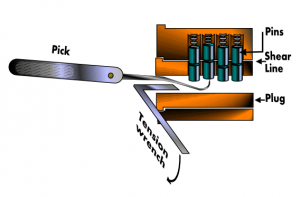Lockpicks are a good tool for a prepper to have. I enjoy the locksport hobby because I enjoy puzzles and seeing how things work.
While, I have no tolerance for crime, and I hate a thief more than anything. Lockpicking does have non-criminal uses.
Inside prison, specially trained key control officers understand how locks work so that they can repair and maintain the locks. Locksmiths on the outside have to have the lock picking skill as well.
For preppers, imagine a large scale collapse – like what Selco describes during the Yugoslav wars. During that time, people spent a large portion of their time scavenging for food. Being able to open locks without obvious signs of entry or damage would be highly useful in that situation.
Additionally, while a bolt cutter and a 12 gauge shotgun can get past almost any normal lock, you can’t relock it after you are done. People will know you were there.
How Lockpicking Works
Lock picking is the art of unlocking a lock by manipulating the components of the lock device using picks instead of the key.
The main components in the pin-and-tumbler design are a series of small pins of varying length.
The pins are paired up with two pins and a spring in each shaft.
There are multiple shafts lined up and running through a central cylinder plug and into the housing around the plug.
The springs at the top of the shafts keep the pin pairs in position in the plug.
The bottom pin in each pair is rests inside the plug, while the upper pin is halfway in the plug and halfway in the housing.
The top pin keeps the cylinder from turning because the pins bind the plug to the housing.
When you insert a key, the series of notches in the key push the pin pairs up to different levels. A correct key will line up the “shear line” between each pin pair at the gap between the cylinder and the housing. This allows the cylinder to turn.
An incorrect key will push the pins so that most of the top pins are still partly in the plug and partly in the housing.
This simple design is very effective.
Since the pins are hidden inside the lock, it is difficult to move the plug without the correct key. However, with a lot of practice, it is possible to open the lock by picking.
Two Main Tools Used to Pick Locks:
- Picks – lockpicks are long, thin pieces of metal that curve up at the end. They are used to reach into the lock and push the pins up
- Tension wrench – Tension wrenches put pressure on the pins by slightly turning the cylinder so that as a pin set reaches the shear line it is held in place.
 The first step in picking a lock is to insert the tension wrench into the keyhole and turn it in the same direction that you would turn the key.
The first step in picking a lock is to insert the tension wrench into the keyhole and turn it in the same direction that you would turn the key.
This turns the plug so that it is slightly offset from the housing around it.
While applying pressure on the plug, you insert a pick into the keyhole and begin lifting pin.
The object is to lift each pin pair so that the top pin moves into the housing while the lower pin remains in the cylinder. Just as it does when it is pushed by a key.
When you do this while applying pressure with the tension wrench, you feel or hear a slight click when the pin falls into position.
The process is to lift each pin pair into the correct position until all of the upper pins are pushed completely into the housing and all of the lower pins rest inside the plug. When you get that done, the plug rotates freely and you can open the lock.
Conceptually, the lock-picking process is quite simple, but it is a can be a difficult skill to master.
Lock Picking and the Law
Although lock picking is usually associated with crime, it is an essential skill for the legitimate profession of locksmithing. Additionally is a hobby called locksport.
In the United States, laws concerning possession of lock picks vary from state to state.
Generally, possession and use of lockpicks is considered equivalent to the possession of a crowbar or any tool that can be used for burglary.
Possession of lock picks with an intent for their unlawful use is generally prosecuted as a misdemeanor under the category of possession of burglary tools or similar statutes.
In many states, simple possession of lock picks is legal, as the statutes only prohibit the possession of lock picks or the activity of lock picking when there is a malicious intent. This is the case in Arizona,California, Utah, Maine, Massachusetts, New Hampshire, Washington D.C., Washington State, and New York.
Some states, such as California and New York, impose restrictions on businesses, such as prohibiting the operation of a locksmithing business without a license and imposing requirements to keep records about sales of lock picking devices.
Where To Buy Lockpicks
Amazon does not allow lockpicking tools to be sold. While some can skirt the rules for a while before getting caught, its not the best place to find tools.
I found a great online site called lockpickworld.com. They sell a variety of kits, tools, and books to get you started. There prices and quality are hard to beat. I fully recommend you visiting them.


